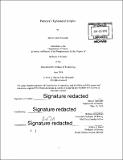| dc.contributor.advisor | William Broadhead. | en_US |
| dc.contributor.author | Holcomb, Steven John | en_US |
| dc.contributor.other | Massachusetts Institute of Technology. Department of Humanities. | en_US |
| dc.date.accessioned | 2016-09-30T19:32:16Z | |
| dc.date.available | 2016-09-30T19:32:16Z | |
| dc.date.copyright | 2016 | en_US |
| dc.date.issued | 2016 | en_US |
| dc.identifier.uri | http://hdl.handle.net/1721.1/104498 | |
| dc.description | Thesis: S.B., Massachusetts Institute of Technology, Department of Humanities, 2016. | en_US |
| dc.description | Cataloged from PDF version of thesis. | en_US |
| dc.description | Includes bibliographical references (pages 77-78). | en_US |
| dc.description.abstract | The story of the third century AD rebellion of the Palmyrene Empire against the Roman Empire remains one of the most curious and fascinating episodes from the ancient world. Palmyra, a wealthy desert city-state, was neither the largest, richest, nor most significant city of the Roman Near East, yet it was the city that capitalized on Rome's weakness in the third century to lead its own independence movement, taking over vast swathes of wealthy territory for a brief period from approximately 270 to 273 AD. But why was Palmyra the city to lead the revolt against Rome? And how was it so successful for such a short time? At first glance, it would appear that Palmyra was ill-suited to successfully carve an independent state. Yet the city's distinctive history and culture actually suggest that it was uniquely positioned to contest Rome for supremacy of the Near East. Palmyra's economic, military, and cultural history left it in an exceptional situation in the third century. This thesis supplements readings of the textual evidence preserved by literary sources including the Historia Augusta and Zosimus with an examination of archaeological, epigraphic, and numismatic evidence to reveal the importance of Palmyra's history in understanding the episode of the Palmyrene Empire. The city's leaders capitalized on their past history and present position to attempt their challenge against Rome which, while ill-fated, is more understandable in the context of the period. | en_US |
| dc.format.extent | 78 pages | en_US |
| dc.language.iso | eng | en_US |
| dc.publisher | Massachusetts Institute of Technology | en_US |
| dc.rights | M.I.T. theses are protected by copyright. They may be viewed from this source for any purpose, but reproduction or distribution in any format is prohibited without written permission. See provided URL for inquiries about permission. | en_US |
| dc.rights.uri | http://dspace.mit.edu/handle/1721.1/7582 | en_US |
| dc.subject | Humanities. | en_US |
| dc.title | Palmyra's ephemeral empire by Steven John Holcomb. | en_US |
| dc.type | Thesis | en_US |
| dc.description.degree | S.B. | en_US |
| dc.contributor.department | Massachusetts Institute of Technology. Department of Humanities | |
| dc.identifier.oclc | 958278344 | en_US |
